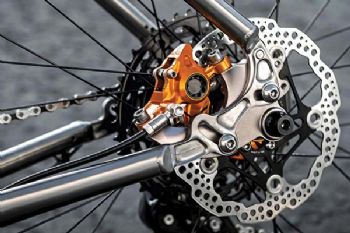
Bicycle aftermarket-component manufacturer Hope Technology employs around 130 people at its Barnoldswick (Lancashire) factory and exports half of its rapidly expanding production to more than 40 countries.
The successful company’s business was based on a quest to make mountain biking safer by developing an alternative to cantilever brakes.
In 1985, founders Ian Weatherill and (the late) Simon Sharp, both former Rolls-Royce Aerospace engineers and tool-makers, set up their own tooling company IPCO (Instant Precision Co) to make jigs and fixtures for local aerospace companies.
They were keen motorcycle trials riders who took up mountain biking as a means of keeping fit. To improve the stopping power of their mountain bikes, particularly in wet and muddy conditions, they developed a disc-brake assembly along the lines of those on their trials motorcycles.
After several years of designing and making hubs and brakes for their own and friends’ use, Hope Technology was formed in 1989 to make disc brakes and hubs.
Today, the top-quality brakes are manufactured in their tens of thousands annually, along with sprockets, chain-rings and virtually every other component that goes onto a mountain bike, as a visit to the company’s Web site (
www.hopetech.com) will attest.
To meet demand, the factory operates 24-7. Even so, by mid-2015 one of the 70 CNC machine tools on the shopfloor — a BySprint CO2 laser cutting machine from Coventry-based Bystronic UK Ltd (
www.bystronic.co.uk) — was struggling to keep up.
Hope Technology’s works and production manager, Lindley Pate, knew that fibre laser cutting was a maturing technology and decided that the time was right to make the change. A 4kW BySprint Fiber 3015 machine was duly installed.
Mr Pate says: “We use relatively thin materials, such as 2mm stainless steel for brake discs and up to 6mm aluminium for some sprockets. Compared with an equivalent CO2 source, the fibre laser produces components three-times faster.
It has made a fantastic difference in helping us to produce components for the high volumes of orders we have to meet.
Moreover, the machine is equally capable of handling much thicker material, and we often process 12mm-thick aluminium tooling plate to produce fixtures for other machines on the shopfloor.”
Mr Pate says a further advantage of fibre laser cutting is the high quality of cut using exclusively nitrogen as the cutting gas. “The as-profiled edges on stainless steel appear polished, so components such as brake discs need no edge finishing. They go straight to on-site heat treatment.
“This is in contrast to production on the previous CO
2 machine, which left a residue — even when nitrogen was used. Oxygen as the cutting gas is not used at all here, to avoid the problems associated with oxidation of the cut metal edges.”
Favourable factors

He says other factors in favour of fibre laser cutting over CO2 are more consistent accuracy, less machine maintenance and lower running costs, both in terms of the amount of electricity used and the amount of cutting gases consumed.
“There is now no need to use helium gas at all, which runs all the time on a CO
2 laser machine; this results in a further significant saving.” The cycle components cut on the BySprint Fiber are mainly brake-disc blanks from 410 stainless-steel sheet in the soft condition.
The discs are either one-piece varieties or two-piece assemblies requiring a stainless-steel outer band and a floating centre of 2014 aluminium, which is also cut on the machine. Additionally, sprocket blanks from 7075 aluminium are produced, as well as bike maintenance tools, merchandise such as bottle openers and key-rings, and parts for display stands and trophies.
The maximum sheet size that can be accommodated on the table of Hope’s fibre laser cutting machine is 3 x 1.5m, which is generally the one used when producing aluminium parts.
In the case of the speciality stainless steel that the company buys, the mill supplies the sheet in a variety of strip sizes; these are typically 330-550mm wide x 1,000-1,500mm long and are placed across the machine’s shuttle table ready for processing.
The variety of stock sizes used was one reason for Hope deciding not to equip the laser cutter with an automated system for delivering fresh material to the machine and subsequently retrieving the laser-profiled sheets.
Mr Pate says another reason is that the Barnoldswick facility is a low- to medium-volume manufacturer of specialised components that need not only CNC machining but also a degree of hand crafting, so large-volume manufacturing principles are not appropriate.
Part programming
Based on design data from Hope’s SolidWorks CAD network, programming is carried out off-line using a seat of Bystronic’s Bysoft 7 software, which Mr Pate says is easy to use and has excellent nesting capabilities
for maximising component output from a sheet.
Programmer Mark Jolly makes particular mention of the scrap cut-down feature in Bysoft; this cuts big areas of waste material inside a component into several smaller pieces, thereby avoiding the risk of a large piece of scrap distorting upwards, which could damage the laser nozzle travelling 1mm above the sheet.
He also appreciates the ease with which the engraving function can be called up at the control by backing off the power output from 4kW to 600W.
In conclusion, Mr Pate said: “We have always believed in making everything in-house from top-quality materials, either solid billet or aluminium forgings.
“We not only machine everything ourselves on CNC equipment to control precision and quality but also heat-treat, anodise, polish and assemble on-site. We are even branching out into in-house carbon-fibre production, which will result in handlebars, seat-posts and even a complete bike being available.
“The Bystronic fibre laser has become an essential tool at the start of the production routes for brake discs and sprockets. There has been minimal down-time since the machine was installed, which is essential. We only operate one laser, so it has to be reliable; otherwise, production would stop.”